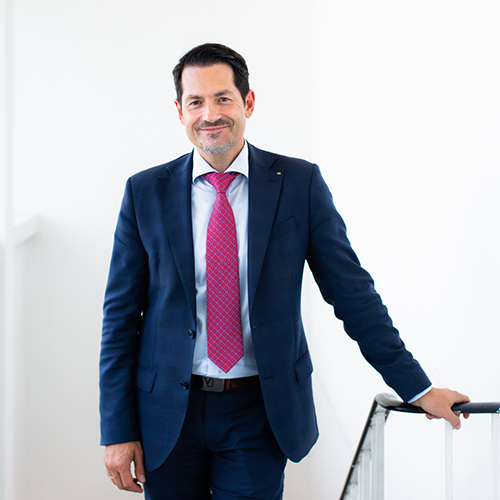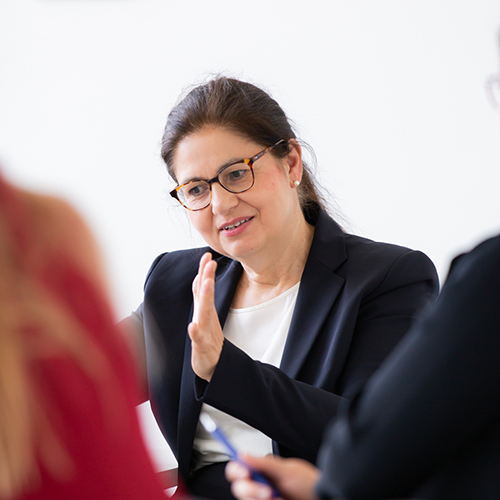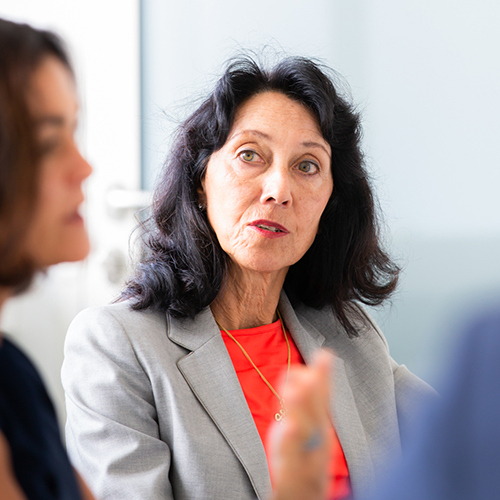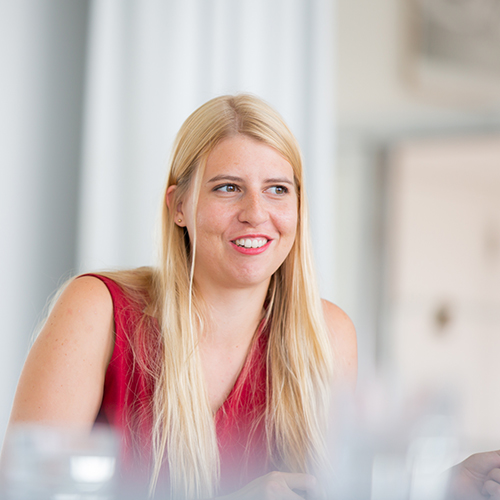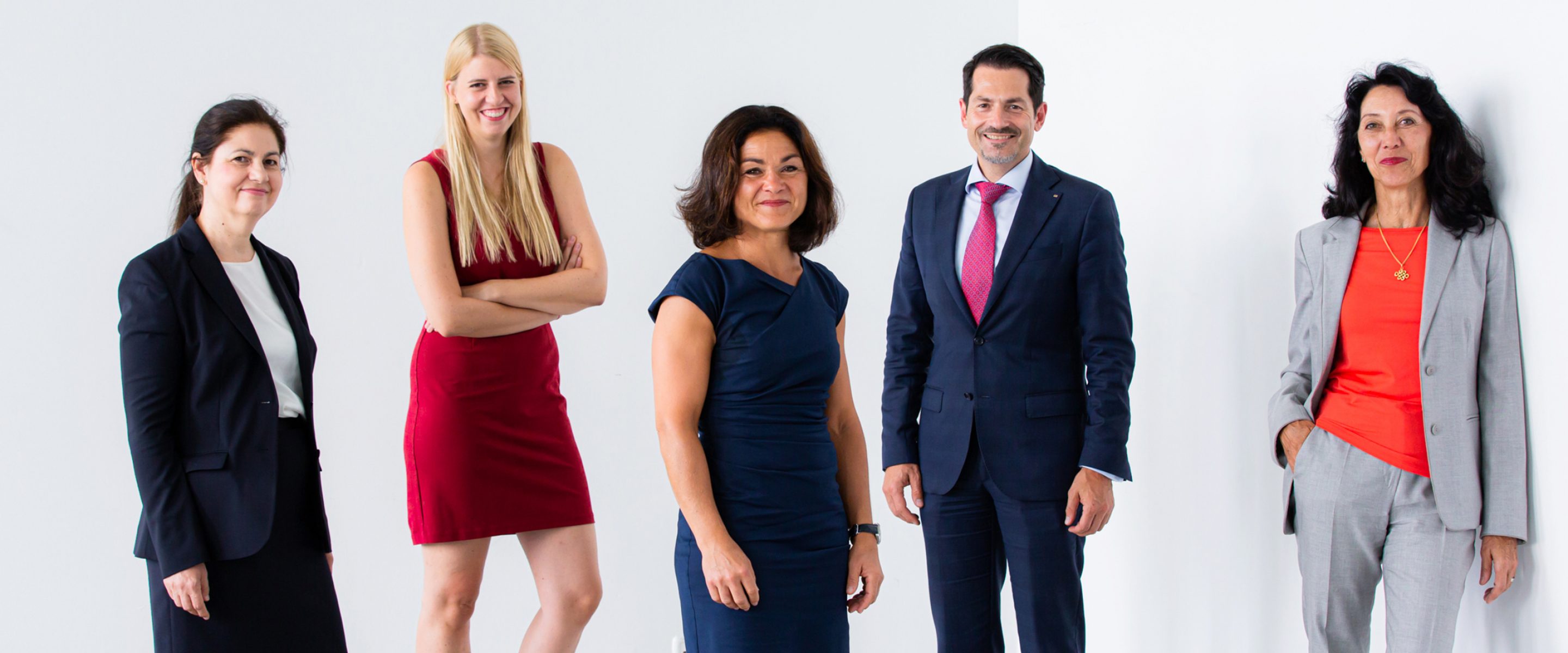
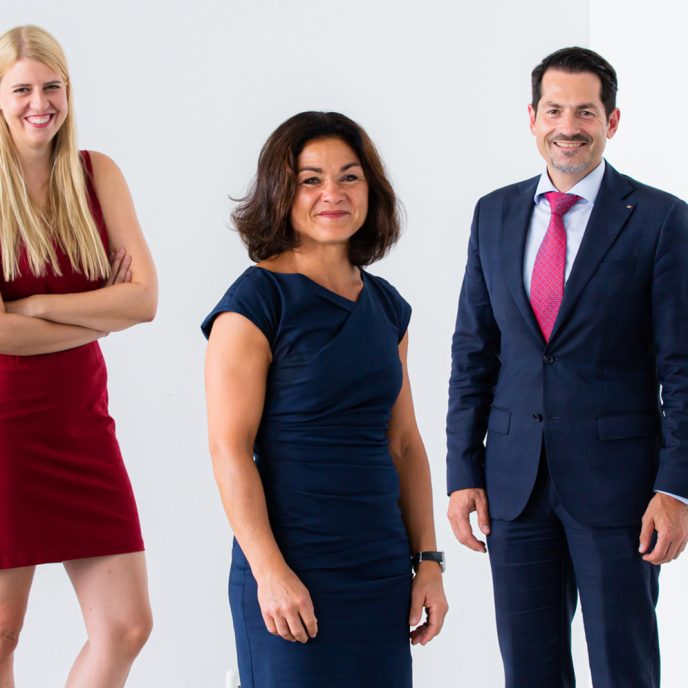
TUM President Thomas F. Hofmann invited four TUM alumnae to the table discussion on digitization: from left to right. Maria Sievert, Laura Lammel, Elisabetta Castiglioni and Pamela Herget-Wehlitz.
For the round table on digitalization, TUM President Thomas F. Hofmann was joined by four female innovators and stimulators who are tackling the challenges of the digital world on a daily basis. What they all have in common is that they are among the pioneers in digitalization in their respective fields and are not afraid to venture down uncomfortable paths to improve their industries. Together they discussed what they are personally enthusiastic about in digital technology, why each and every one of us should play an active role in shaping digitalization, and to what extent the corona crisis can be seen as a wake-up call for Germany in particular.
Welcome to Munich, Dr. Castiglioni. We are very pleased that you could make it.
Dr. Elisabetta Castiglioni: With pleasure. After all, we have an important topic to discuss today. Digitalization concerns all of us, although perhaps in different ways.
Dr. Pamela Herget Wehlitz, for many years Chief Information Officer of the German engine manufacturer MTU Aero Engines, and developer Laura Lammel, Managing Director of the family-owned company of the same name and Vice President of Landesverband Bayerischer Bauinnungen [Bavarian Regional Association of Construction Guilds], join the group at the same time.
Laura Lammel: It’s so nice to be back at TUM. It’s been a while since I studied (laughs). I more frequently come to the Munich University of Applied Sciences, for example when I give presentations on digitalization in the construction industry.
Dr. Pamela Herget-Wehlitz: I read that this is a difficult field: digital technology in the construction industry.
Laura Lammel: To be honest, sometimes I am envious of companies like MTU with a “standing production”. With every order we are confronted with a new situation: every structure is different, every construction site is different. We find good siloed solutions, but it is hardly possible to optimize the overall process in such a way that allows us to use only one single digital solution for a large part of the work.
President Thomas F. Hofmann enters the room and cordially welcomes the women present.
Prof. Dr. Thomas F. Hofmann: How nice to have you all here at TUM today and that you are taking the time to talk to us. I know that each of you has a full schedule – myself included (laughs). That makes us all the more grateful.
President Hofmann, we have just been talking about the major challenges that digitalization is creating for the construction industry.
Thomas F. Hofmann: Indeed, we have experienced this here at the university as well. At the Department of Civil, Geo and Environmental Engineering we had a massive drop in students about five to ten years ago. As a result, we modernized the degree programs with topics such as digital construction and other specializations. As a result, student numbers are now shooting up again. Following Informatics, Mathematics and Economics, this is the department with the fastest growing student numbers. By the way, offering relevant content in line with the latest trends is the way to attract the best talent to the university. After all, that is our mission as a university: to groom experts for the future.
Laura Lammel: That is definitely very important, however, my experience is that practical experience often throws a wrench into the works. I was lucky to experience the New Economy and the huge hype at Stanford. That was when I understood what digitalization meant and how it was used in the USA at that time. With these ideas I came back to Germany. Unfortunately, there had been a construction crisis here since the end of the 1990s, we had to lay off employees and all I was able to do digitally was a switch from MS Dos to Microsoft. When I started to work with associations in 2012 and the topic of digitalization was discussed there, I raised my hand and said: “I know something about that.“
How did you proceed with the implementation?
Laura Lammel: I listen carefully to what experts from other industries or start-ups tell me, adapt projects and tools for the construction industry and then try to implement them stringently. At the same time I advise medium-sized companies on their way into the digital age. But even today, many companies in the construction sector still don’t have a website or email address. On top of that, construction workers are often not trained to use digital tools. And vice versa, some contractors now send each other construction plans only via WhatsApp and then find it surprising that they are full of errors.
Dr. Herget-Wehlitz, you joined the engine industry as an engineer in 1985 right after finishing your studies. What role did digitalization play for you back then?
Pamela Herget-Wehlitz: In the engine industry, digitalization indeed was an issue at a very early stage. As a young engineer, I started out in the aerodynamics department, where a lot of programing had to be done. Our department was a big one, and we developed the computing processes ourselves because something like that didn’t exist on the market yet. We had the first supercomputers – that was really great and fancy. But of course no PCs and no text programs or anything like that. That only started in the late eighties. It was a lot of “learning on the job”: we developed new products and that required the new digital tools, which we subsequently developed. That was always a back and forth process. Digitalization is not a project with a beginning and an end, it is an ongoing process.
What do you mean?
Pamela Herget-Wehlitz: As technologies are constantly evolving, you have to constantly question your own approach and the use of the tools. For example, the topic really took off in the 1990s when the Internet and email began to take hold. As a result, programs for collaboration became more important. Twice in my career, I have introduced a product data management system, which means that you have to deal with quite a few divisions of the company at the same time and makes you realize how connected things are. It makes you think really hard about what you’re doing because you can relatively quickly screw up the company with something like that. Misguided digitalization can be quite dangerous.
Elisabetta Castiglioni: The development of digital technologies over the past twenty years has been a challenge for many industries and companies, and I think many people still show great respect for such technologies. Successful digitalization requires strategy, resilience and courage. It forces us to focus on what is relevant and important, even if that means doing something that is far outside our comfort zone.
How did the companies deal with that?
Elisabetta Castiglioni: Any big change is initially painful. However, in order to survive in the long term and develop as a company, it is worth making the necessary cuts. It is better to courageously face the challenges of the time in order to recognize changes early enough and to be able to implement them actively and strategically. If you jump on the bandwagon too late, you may no longer be able to navigate yourself, but you will be navigated. One result of this development is that IT today is no longer a pure service provider, but has become a kind of catalyst and part of the corporate DNA. This applies to all industries.
need to keep the conversation going.”
Prof. Dr. Thomas F. Hofmann
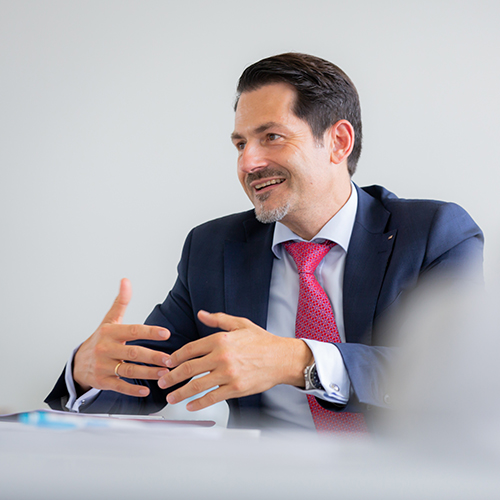
TUM President Thomas F. Hofmann at the table discussion on digitization (Image: Magdalena Jooß / TUM).
Ms Sievert, as the youngest in this group, you are one of the so-called digital natives. Is everything in your start-up fully digitized?
Maria Sievert: Indeed, we did start with a very young team. This means that there is an enormous amount of openness to digital products. The opposite of what you are describing happens: everyone has a new suggestion as to which digital tool we could also use. We then have to carefully consider whether the tool is suitable for the task at hand. We need to make sure we don’t get too diversified.
Pamela Herget-Wehlitz: I believe this is important. You have to approach things from the perspective of the problem and the processes and not from the program or digital tool that is available. That’s where a lot of people take a wrong turn and put the cart before the horse. A digital solution really has to fit the problem, otherwise it just creates more complexity. And if you do it right, you can even bring on board people who may not be digital natives.
Maria Sievert: We are currently standardizing the project management tool in all teams. This requires a lot of discipline from all participants until you reach the point at which the benefits of the system actually come through. Sometimes, however, we deliberately wait longer before introducing new tools until the team is almost crying out for help itself and says that it can’t get anywhere with Post-its and pens anymore (laughs). Then we say: “We might have something to help”. That way the team can be won over a little faster.
Laura Lammel: Digitalization also has to be properly communicated. Without direct human-to-human communication, we will not succeed in changing processes and streamlining procedures through digitized structures and artificial intelligence. To do that we need time, empathy, courage and persuasiveness.
President Hofmann, how important is computer science in the education of students?
Thomas F. Hofmann: Computer science really should be a core subject in every degree program. The traditional canon of Natural Sciences consisting of Mathematics, Physics and Chemistry has to be expanded by Computer Science as a fourth pillar. Even a physician needs to have a basic understanding of it: they don’t have to be a software developer, no no, but they have to be trained to be able to speak and communicate with a computer scientist. It’s all about basic “digital skills”, which everyone will need in the future to remain professionally successful.
Elisabetta Castiglioni: Many of our customers are from the SME sector and frequently ask me if they need to hire a data scientist now. And if so, where they would even find one (laughs). We try to reassure our customers and tell them to focus on their core competencies and not to worry. Of course, a basic understanding and courage to tackle the digital transformation is essential. The right partner will support you in the rest.
How can this be conveyed to employees who have graduated a while ago and who are not digital natives?
Thomas F. Hofmann: As a university, we see it as our duty to offer further training for alumni and executives. Recently, we have established the TUM Institute for Life Long Learning, which offers professional and executive education. Training is provided through a clever combination of in-class and digital learning, so that employees don’t have to leave the company for too long and can integrate training into their day-to-day work.
Would you say that Germany has missed the boat on digitalization?
Thomas F. Hofmann: I wouldn’t go that far. We did have some innovative ideas, but we did not sufficiently scale up and explore promising areas of application. Looking at the construction industry, this can be demonstrated very well. As we have already heard, actual digitalization is not yet a reality here. At the same time, construction used to be a sector in which we Germans were able to really score points. Meanwhile, we have lost a significant lead. We have rested too long on the fact that we have traditionally been strong in the manufacturing sectors and have shown too little courage to rethink and redirect.
What do you mean by that?
Thomas F. Hofmann: I remember a report from four or five years ago: Our current Minister for Economic Affairs met the Head of Google at Stanford. The minister boasted that Germany is making the best cars. And the Head of Google replied dryly: “Yes, that’s true. But that’s why we are buying your engineers.” At the end of the day, fortunately, it didn’t quite come to that. But who would have thought back then that Tesla would one day set up a plant in Germany as large as the one in Brandenburg. The world is moving incredibly fast and is not waiting for Germany. We have to keep at it and that’s what we’ll do. We have a lot of know-how and very well educated people in the country. They have to be convinced to stay here.
Maria Sievert: We have found that the motivation for a cause is a decisive factor for young professionals to decide for or against a profession, a company or a country. After all, in our start-up there are many computer scientists and engineers from TUM. They found it exciting not to go into the automotive industry, but to use their know-how in medical engineering and for a good cause. Our task is to improve cancer diagnostics. Everyone can relate to that because everyone has someone in their circle of friends or family who is affected by the disease.
Thomas F. Hofmann: This is something we also notice with the students. They are looking for tasks that are both exciting and important. I wanted to study Chemistry back then because I was interested in laboratory work – that’s what I was passionate about. But today you no longer hear something like that from any student. They say: “I want to achieve something, I want to make a difference, I want to have a purpose.” That’s what drives them. You have to meet the students where they are and offer them good-quality, innovative programs.
Pamela Herget-Wehlitz: Speaking from the perspective of a large company, I have to say that it is of course not always easy to take all employees with you on the road to digitalization. What we have done is that two years ago we recruited a number of young people with an affinity for digital technology for the relevant departments: with a good, digital education and three to five years of work experience. We placed them in the respective units with the task of taking a look at the processes there, thinking ahead and bringing the other people in there along. This ensures that even those who have fallen behind a bit have a chance to catch up and get back on the job. The model worked extremely well: the combination of experienced specialists and young, motivated people who always wanted a little bit more really was fantastic.
Thomas F. Hofmann: That’s indeed the difficulty of a transformation, no matter if it is digital or any other kind. First you have to spread sufficient motivation, otherwise nothing will happen. A stagnant system will not move on its own. Sometimes the greatest danger is to believe that things will always continue as before.
Laura Lammel: We have just witnessed that with the coronavirus. Hofmann: Health implications aside, the corona crisis has been a real wake-up call, which has brought to light where TUM was lagging behind. Of course, we already had digital contents in teaching and are glad about that now. Nevertheless, the corona crisis has brought about a quantum leap at TUM. We had four weeks to convert the entire 2020 summer semester to digital content for our 42,000 students, who of course are entitled to continue with their studies, and whom we now need – more than ever before – out there as qualified professionals. This was an enormous community effort: every lecturer, the entire academic staff, the administration and the students themselves pitched in. We recruited 500 student e-scouts who helped the lecturers to edit films and really make the digitization of the formats a reality. TUM is known for advancing relatively quickly, but without the crisis we would not have been able to implement such a comprehensive, scaled transition for the next three years. That is something we will benefit from in the future.
As the experts sitting here, what are your wishes and visions for the further development of digitalization?
Maria Sievert: As entrepreneurs, we all somehow have this curiosity and hunger to improve things. For me, digitalization is not an end in itself – digitalization just because that’s what people do – no, but because I want to use it to achieve something. As a tool to make things better. In our case: a chance to avoid false diagnoses of cancer in the future.
Laura Lammel: With regard to digitalization, it is important to take the entire society on board with us. People of all ages, with different educational backgrounds and nationalities. Digital technologies should be available to everyone, and at the same time it should be clear that it is still nice to be able to read a book.
Pamela Herget-Wehlitz: Like any technology, digitalization can be seen in both positive and negative ways. We have to get a grip on certain things, such as cybersecurity or this massive dependence on a few software manufacturers. This is where I would like to see politics come to the rescue. I would be thrilled if society as a whole would succeed in ensuring that we can use the bright side of digitalization and keep the negative aspects in check.
Elisabetta Castiglioni: More initiatives to boost digitalization in and for Europe! One such initiative is GAIAX, the European Cloud, which stores and processes data in accordance with European data security standards. We have to gradually free ourselves from our dependence on the United States and China.
Thomas F. Hofmann: A very, very important topic: Europe’s sovereignty in digital technologies. To achieve that, we need a pan-European push. Together with a project group, we have just drafted a paper on a so-called “European Public Sphere”, a digital ecosystem that follows European values such as privacy, openness and diversity. In addition, I would like to see a stronger alliance between academia and business – especially when it comes to digitalization. As a university, we are sometimes criticized when we collaborate with the industry. What they say is that academia is selling out. That really is nonsense. We don’t let anyone dictate what to do research on. We have our standards. However, talking to experts like you today, it is relatively clear how essential it is to work closely together, both in terms of education and research, which we use to create technological innovations. Why is Stanford, for example, so successful? Because Silicon Valley has created an ecosystem where science, business, start-ups and established global players all spur each other on. They exchange ideas, new things are created and directly implemented. This spiral of innovation is what I would like to see here in Germany, too.
Thank you very much for the interesting conversation.
The lively discussion has set a lot in motion. After the discussion, the participants continue to stand together, exchange business cards, arrange further meetings and collaborations in the near future. Everyone agrees that they want to continue to support the development of digital technologies and digital sovereignty in a European context. It is not too late for that – on the contrary: it is only just beginning.
